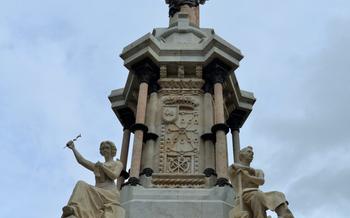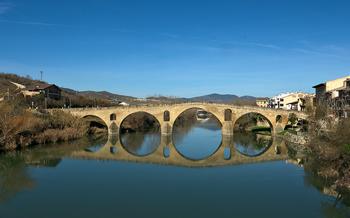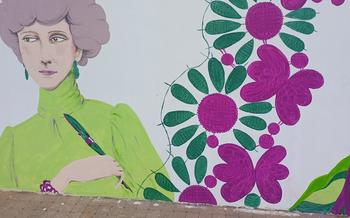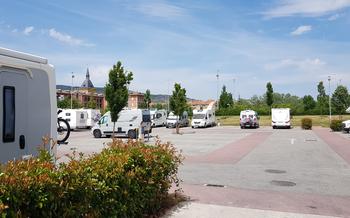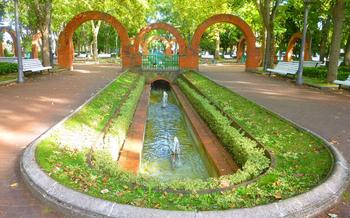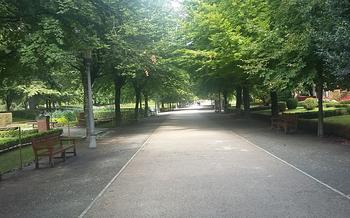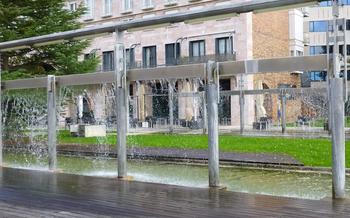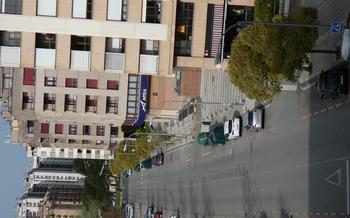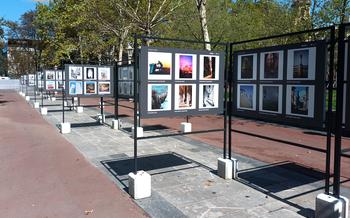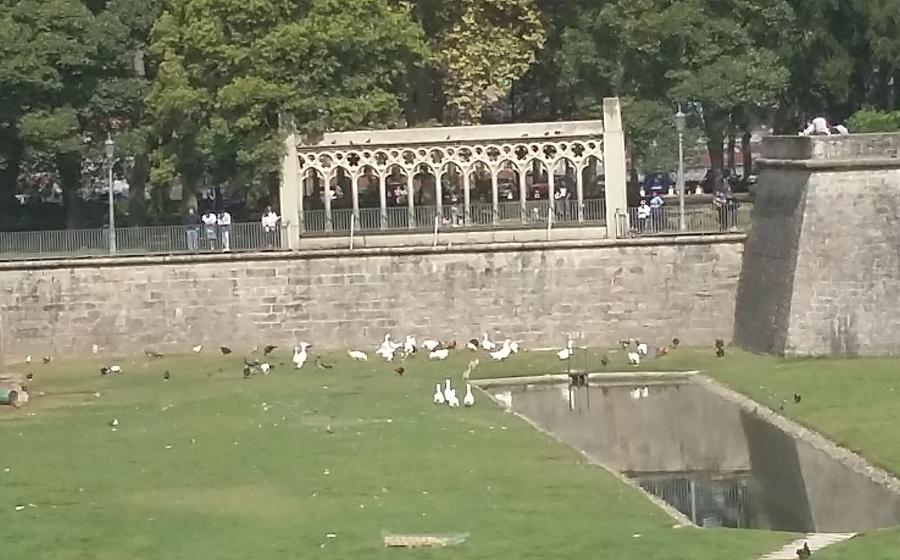
Parque de la Taconera
- Parque de la Taconera: A Green Oasis in Pamplona
- Strolling Along the Paseo de Sarasate
- Visiting the Ciudadela de Pamplona
- Exploring the Rose Garden
- Enjoying a Picnic or a Relaxing Afternoon
- Attending Events and Concerts
- Birdwatching and Wildlife Spotting
- Visiting the Museo de Navarra
- Playing in the Children's Playground
- Visiting the Planetarium
- Exploring the Japanese Garden
- Attending the San Fermin Festival
- Insider Tip: Discovering Hidden Gems
Parque de la Taconera: A Green Oasis in Pamplona
In the heart of the vibrant city of Pamplona, nestled between the bustling streets and historic landmarks, lies the Parque de la Taconera, an enchanting green oasis that offers a tranquil escape from the urban hustle. With its sprawling lawns, meandering paths, and an array of attractions, the park has become a beloved destination for locals and tourists alike.
History and Significance
The Parque de la Taconera holds a significant place in Pamplona's history. Originally a royal hunting ground in the 15th century, it was later transformed into a public park in the 19th century, becoming one of the first urban parks in Spain. Over the years, the park has undergone several renovations and expansions, each adding its unique charm and character to the landscape.
Location and Accessibility
Conveniently situated within the city center, the Parque de la Taconera is easily accessible on foot, by bicycle, or by public transportation. Its proximity to other major attractions, such as the Plaza del Castillo and the Pamplona Cathedral, makes it an ideal starting point for exploring the city.
Strolling Along the Paseo de Sarasate
Adjacent to the Parque de la Taconera, the Paseo de Sarasate is a beautiful promenade that offers a tranquil escape from the hustle and bustle of the city center. This elegant walkway is lined with majestic trees, colorful flowers, and ornate lampposts, creating a picturesque setting for a leisurely stroll.
As you wander down the Paseo de Sarasate, take a moment to admire the stunning monuments and landmarks that grace its sides. The Plaza del Castillo, the heart of Pamplona's old town, is particularly noteworthy, with its grand architecture and lively atmosphere. The Monumento a los Fueros, a monument dedicated to the ancient rights and privileges of Navarre, is another highlight, standing tall and proud at the end of the promenade.
Visiting the Ciudadela de Pamplona
The **Ciudadela de Pamplona la Taconera. It is a star-shaped fortification built in the 16th century under the reign of King Philip II to protect the city from potential attacks. The Citadel played a crucial role in defending Pamplona throughout history, withstanding numerous sieges and conflicts.
Today, the Ciudadela has been transformed into a cultural and recreational space, open to the public for exploration and enjoyment. Visitors can wander through its well-preserved ramparts, admire its imposing gates, and delve into its intriguing history. The Citadel also houses several cultural institutions, including the Museo del Carlismo, which showcases the history and significance of the Carlist Wars, and the Archivo Real y General de Navarra, which preserves valuable historical documents and archives.
In addition to its historical significance, the Ciudadela offers a variety of attractions for visitors. The Plaza de Armas, the main square within the fortress, often hosts concerts, exhibitions, and other cultural events. The Citadel also features beautiful gardens, walking paths, and a children's playground, making it a popular spot for families and outdoor enthusiasts.
Exploring the Rose Garden
Home to over 900 varieties of roses, the Rosaleda del Parque de la Taconera is a fragrant paradise that blooms with color from May to October. Each rose bush bears a unique charm, from the delicate petals of the Alba roses to the vibrant hues of the Hybrid Teas and Floribundas. Take a leisurely stroll through the rose-lined paths, inhaling the heady perfume that fills the air.
The best time to visit the rose garden is in June, when the roses are in full bloom, their vibrant colors creating a breathtaking spectacle. Whether you're a rose enthusiast, a nature lover, or simply seeking a tranquil retreat, the Rosaleda del Parque de la Taconera offers an enchanting experience that will leave you captivated.
Enjoying a Picnic or a Relaxing Afternoon
Designated picnic areas within the Parque de la Taconera offer a delightful opportunity to enjoy a leisurely meal surrounded by tranquil greenery. These areas are typically equipped with tables and benches, providing a comfortable spot to unpack your picnic basket and savor a homemade feast.
Beyond the designated areas, the park's sprawling lawns invite you to spread out a blanket and bask in the warm Spanish sun. Whether you prefer to read a book, take a nap, or simply soak in the serene atmosphere, the park offers a haven of tranquility amidst the bustling city.
Various facilities and amenities enhance your experience in the park. Refreshment kiosks provide a convenient option for grabbing a snack or a drink, while restrooms ensure your comfort during your visit. Additionally, the park features a playground, offering a fun and safe space for children to burn off some energy while you relax and enjoy the surroundings.
Attending Events and Concerts
The Parque de la Taconera is a vibrant cultural hub that hosts a variety of events and concerts throughout the year. These events bring the community together and offer visitors a chance to experience the park's lively atmosphere.
Music concerts are a regular feature, with local and international artists taking to the stage to entertain audiences with a diverse range of genres, from classical to rock and pop. These concerts are usually held in the summer months, when the weather is at its best and the park is teeming with life.
Cultural festivals and celebrations are also held in the park, showcasing the rich traditions and heritage of Pamplona. These festivals often feature traditional music, dance, and food, providing visitors with an immersive experience of Basque culture.
To find out about upcoming events and concerts, check the park's official website or visit the tourist information office in Pamplona. Tickets for events can be purchased online or at the gate.
Here's a tip for getting the most out of your event experience: arrive early to secure a good spot, especially for popular concerts and festivals. Pack a picnic or snacks to enjoy during the event, as food and beverage options may be limited. And remember to dress comfortably and bring a blanket or chair for seating on the grass.
Birdwatching and Wildlife Spotting
The Parque de la Taconera is a haven for birdwatchers and nature enthusiasts. The park's diverse habitat attracts a wide variety of bird species, including many migratory birds that stop over during their seasonal journeys. Some of the common bird species that can be spotted in the park include goldfinches, blue tits, great tits, and blackbirds. Additionally, the park is home to a population of squirrels, rabbits, and other small mammals.
For the best birdwatching experience, visit the park early in the morning or late in the afternoon when the birds are most active. Bring a pair of binoculars and a field guide to help you identify the different species. There are several birdwatching spots in the park, including the Paseo de Sarasate, the Rose Garden, and the Japanese Garden.
Visiting the Museo de Navarra
The Parque de la Taconera is home to the Museo de Navarra, a treasure trove of art, history, and culture. This museum houses a diverse collection of artifacts, paintings, and sculptures that narrate the rich past of Navarra and its people.
Collections and Exhibits:
The museum's collection spans from prehistoric times to the present day, offering a comprehensive journey through Navarra's history and artistic heritage. Highlights include Romanesque sculptures, medieval paintings, and works by renowned contemporary artists. Particularly noteworthy are the museum's collection of prehistoric artifacts, including the iconic Dama de Elche, a 5th-century BC sculpture that is considered one of Spain's most significant archaeological treasures.
Admission Fees and Hours:
Admission fees to the Museo de Navarra are quite reasonable, with discounts for students, seniors, and groups. The museum's hours vary depending on the time of year, so it's advisable to check their website or call ahead to confirm before visiting.
A visit to the Museo de Navarra is a must for anyone interested in learning more about the history, culture, and artistic traditions of this vibrant region. With its diverse collection and well-curated exhibits, the museum offers a fascinating glimpse into the rich tapestry of Navarra's past.
Playing in the Children's Playground
The Parque de la Taconera also features a dedicated children's playground, providing a safe and entertaining space for young visitors to let loose and have fun. The playground is equipped with a range of facilities and activities designed to cater to different age groups and interests.
Children can swing and climb to their hearts' content, with various swings and climbing structures. There are also slides, seesaws, and a merry-go-round for a more traditional playground experience. Sandpits and water features offer opportunities for imaginative play and sensory exploration.
The playground is designed with safety in mind, with soft surfaces and well-maintained equipment. Parents and guardians can relax on nearby benches while keeping an eye on their little ones as they play. The playground is a popular spot for birthday parties and family gatherings, with designated picnic areas available for convenience.
Visiting the Planetarium
The Parque de la Taconera also houses a planetarium, a fascinating attraction for astronomy enthusiasts and anyone interested in exploring the wonders of the cosmos. The planetarium features a state-of-the-art projection system that displays captivating shows and programs on astronomy, space exploration, and the wonders of the universe.
Visitors can embark on a journey through the solar system, witness the birth and death of stars, and explore distant galaxies. The shows are presented by knowledgeable and enthusiastic astronomers who provide insightful commentary and explanations, making the experience both educational and entertaining.
Ticket prices for the planetarium shows vary depending on the type of show and the time of day. It's advisable to check the planetarium's website or contact them directly for the most up-to-date information on showtimes and ticket prices. Reservations are recommended, especially during peak tourist season, to avoid disappointment.
Exploring the Japanese Garden
The Parque de la Taconera also boasts a serene Japanese garden, a hidden gem that exudes tranquility and cultural charm. Inspired by the principles of Zen Buddhism, this garden invites visitors to find inner peace and harmony amidst its meticulously landscaped elements. Wander through the winding paths, past tranquil ponds and over arched bridges, admiring the vibrant colors of koi fish and the delicate beauty of cherry blossoms in season. Take a moment to sit in one of the traditional teahouses and savor a cup of matcha tea while contemplating the garden's serene beauty. The Japanese garden is a true oasis within the park, offering a unique and immersive experience that transports visitors to the Far East.
Attending the San Fermin Festival
The vibrant atmosphere of the San Fermin festival engulfs the Parque de la Taconera, as it becomes a focal point of the festivities. During this time, the park transforms into a stage for lively performances, concerts, and traditional dances. Food stalls and kiosks line the alleys, offering delectable local cuisine and refreshments to festival-goers.
As the sun sets, the park erupts in a symphony of colors with the spectacular fireworks display. The night sky illuminates with dazzling hues, creating a magical ambiance that captivates all who witness it. Be sure to join the throngs of people gathered on the park's lawns, enjoying the spectacle and the infectious energy that permeates the air.
If you happen to visit Pamplona during San Fermin, don't miss the opportunity to immerse yourself in the festivities at the Parque de la Taconera. Embrace the jovial spirit, indulge in the culinary delights, and let the infectious rhythm of the fiesta carry you away. Just remember to navigate the crowds with caution and respect the local customs to ensure a safe and enjoyable experience.
Insider Tip: Discovering Hidden Gems
Beyond the main attractions, the Parque de la Taconera holds secret gems waiting to be discovered by curious explorers. One such hidden treasure is the secluded rose garden, tucked away amidst towering trees. Here, visitors can admire a stunning collection of roses in full bloom, creating a fragrant and colorful oasis.
Another hidden gem is the labyrinth, a delightful maze of winding paths that challenges visitors to find their way through. Perfect for a playful adventure, the labyrinth offers a fun and unique experience for visitors of all ages.
For those seeking tranquility, the park's Japanese garden provides a serene retreat. Inspired by traditional Japanese aesthetics, the garden features a tranquil pond, meticulously manicured plants, and symbolic elements that evoke a sense of peace and harmony.
Whether it's the secluded rose garden, the challenging labyrinth, or the serene Japanese garden, these hidden gems add an extra layer of charm and exploration to the already enchanting Parque de la Taconera.

